INTRODUCTION

For over 20 years now out of all the hardware components we use in our personal computers only one has remained essentially the same not only in size and shape but also in its inner workings, the 3.5" hard disk drive. Certainly many improvements have been implemented over the years (mainly as means to increase durability, capacity and read / write performance) such as a serious increase in cache sizes, rotational/spindle speeds and platter density but we've also seen new technologies introduced including various environmental sensors (used to monitor temperature, humidity and pressure) and perhaps the most recent and significant shingled magnetic recording (soon to be replaced – probably - by the highly anticipated heat-assisted magnetic recording which will allow for even greater storage capacities). These new technologies are mainly the reason we now have 10TB models available now and after our reviews of the IronWolf and Barracuda Pro 10TB models by Seagate today we'll be testing their flagship model the Enterprise Capacity 3.5 V6 10TB hard disk drive.
Founded in 1979, Seagate is the leading provider of hard drives and storage solutions. From the videos, music and documents we share with friends and family on social networks, to servers that form the backbone of enterprise data centers and cloud-based computing, to desktop and notebook computers that fuel our personal productivity, Seagate products help more people store, share and protect their valuable digital content. Seagate offers the industry’s broadest portfolio of hard disk drives, solid-state drives and solid-state hybrid drives. In addition, the company offers an extensive line of retail storage products for consumers and small businesses, along with data-recovery services for any brand of hard drive and digital media type. Seagate employs more than 50,000 people around the world.
The new Enterprise Capacity 3.5 V6 10TB hard disk drive (available with SAS and SATA connectivity - 12TB model was just announced) is placed inside the same aluminum forged enclosure (at least in terms of looks) we've seen used with the Barracuda Pro and IronWolf models and features 256MB of cache, 14 read/write heads and 7 platters (1.5GB each) with a spindle speed of 7200RPM. However what sets it apart compared to the other two 10TB models we've tested by Seagate is the type of gas used inside since instead of air Seagate has used helium which reduces friction on the platters and allows for even higher disk density (the weight of the drive is also slightly reduced as should be its temperatures and power consumption). The Enterprise Capacity 3.5 V6 10TB HDD also features several digital environmental sensors (used to monitor humidity, pressure and temperature) and several technologies including advanced caching algorithms, PowerBalance (optimizes performance/watt efficiency - more power when required), PowerChoice (the equivalent of sleep mode during idle - lower power consumption) and SuperParity (error correction firmware with RAID rebuild functionality - results in faster RAID rebuild times). In terms of endurance Seagate gives the Enterprise Capacity 3.5 V6 10TB an MTBF (meantime between failures) of 2.5 million hours (this is over two times as much as the one of the Barracuda Pro 10TB), endurance rating of 550TB per year (almost twice as much as the Barracuda Pro) and covers it with a 5 year limited warranty.
SPECIFICATIONS AND FEATURES
THE ENTERPRISE CAPACITY 3.5 V6 10TB
Once again we received our sample in bulk form so it's just the drive inside a clear plastic box.
The enclosure of the Enterprise Capacity 3.5 V6 10TB HDD is virtually the same as the Barracuda Pro and IronWolf drives (minus the different stickers at the top).
The top sticker includes information about the drive such as its serial and part numbers, barcodes, firmware version installed, PSID key and SBR number.
Seagate has placed a 2nd sticker at the front of the drive which you can remove to have the PSID key close to you.
Turning the drive over we see that once again all the modules are placed on the interior of the PCB for increased protection (we also see the same empty area on the right top corner which may or may not be used with an SSD module in future models).

The typical SATA power and data connectors are placed at the rear of the drive right next to 4 pins.
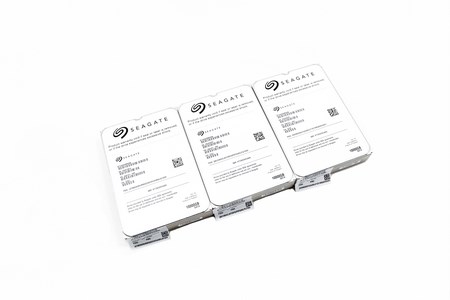
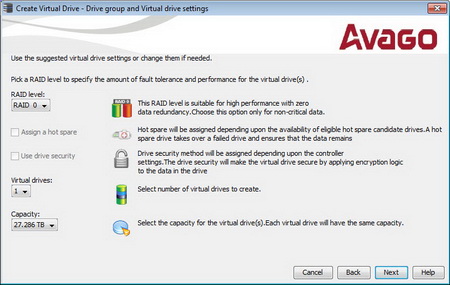
Seagate was kind to provide us with three Enterprise Capacity 3.5 V6 10TB hard disk drives so we can test them and see just how fast they are in RAID 0.
TEST BED


TESTING METHODOLOGY
Thoroughly testing hard disk drives may require time and patience but that's just about it. Of course that doesn't mean that one must take it lightly, at least not when people base their decision on your results. True some choose to only use 2 or 3 benchmarking suits in order to measure the performance of a drive or drives since quite honestly most benchmarking suites do tend to agree with each other (so it's not really wrong) but we always like to take things a step further not because we have to but because we want to be almost 100% certain of the results we get and post in our charts.
So in this kind of reviews we will use a total of 7 different benchmarking suites in an effort to bring you the most accurate results across the board. Now the only reason why i say effort is because real-world usage is not always on par with what results one gets by running several benchmarks on a drive and that's mainly because there are many variables at work from ambient temperatures to hardware configurations and even firmware versions. The benchmarking applications we use are the AIDA64 suite (former Everest Pro), HD Tune Professional (as of October 2016 we also record seek times), HD Tach RW, ATTO, Sisoftware Sandra Pro, Crystal Disk Mark 64bit and the PCMARK 7 (secondary storage suite). These benchmarking tools are the best in what they do and as you will also see later on their results more or less agree. Each test is performed a total of 6 times and then the average is recorded into the charts. Temperatures are recorded using Hard Disk Sentinel and after 45 minutes of continuous testing in a 23 degrees Celsius temperature controlled room. Finally we also use an ExTech HD600 dBA meter on each of the drives (5cm away) in order to accurately record their noise levels (during access), although if you don't turn off all system fans when doing so it's quite possible that you will never even hear the drive. The operating system as usual is a fresh installation of Microsoft Windows 7 Ultimate Service Pack 1 with every update installed up until the 5th of March 2017.
Since there are many people out there (mostly professionals and enterprise users) who have asked if it's possible to include RAID 0 tests with our hard disk drive reviews we decided to do so and so this will always be the case (providing of course we get more than a single drive) with all the available drives we have in our disposal. All RAID 0 tests are performed on the Avago/LSI MegaRAID 9271-8i SAS/SATA III 6Gb/s card (cache disabled) and with different configurations in both ATTO and Crystal Disk Mark since with normal single drive settings the results are far from accurate.
TEST RESULTS - AIDA64 / ATTO


TEST RESULTS - HD TACH RW / HD TUNE PRO



TEST RESULTS - SISOFTWARE SANDRA PRO / CRYSTAL DISK MARK X64


TEST RESULTS – PCMARK 7 / TEMPERATURES / NOISE LEVELS


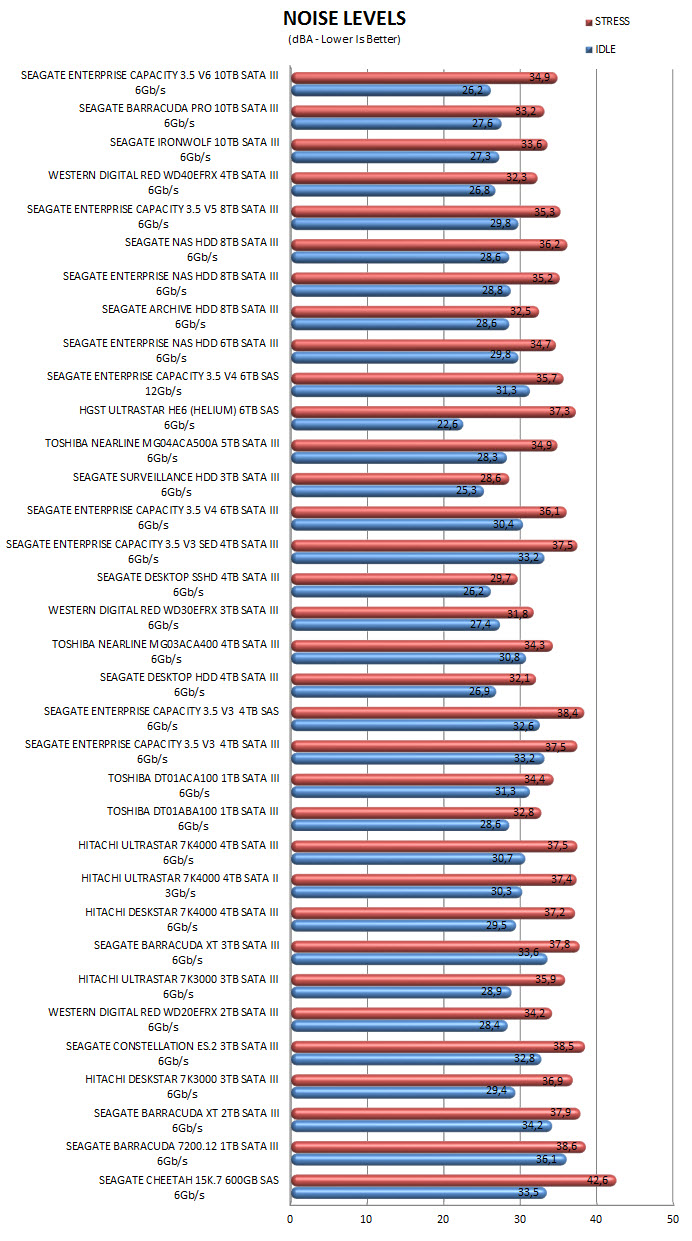
TEST RESULTS – RAID 0 PART 1



TEST RESULTS – RAID 0 PART 2


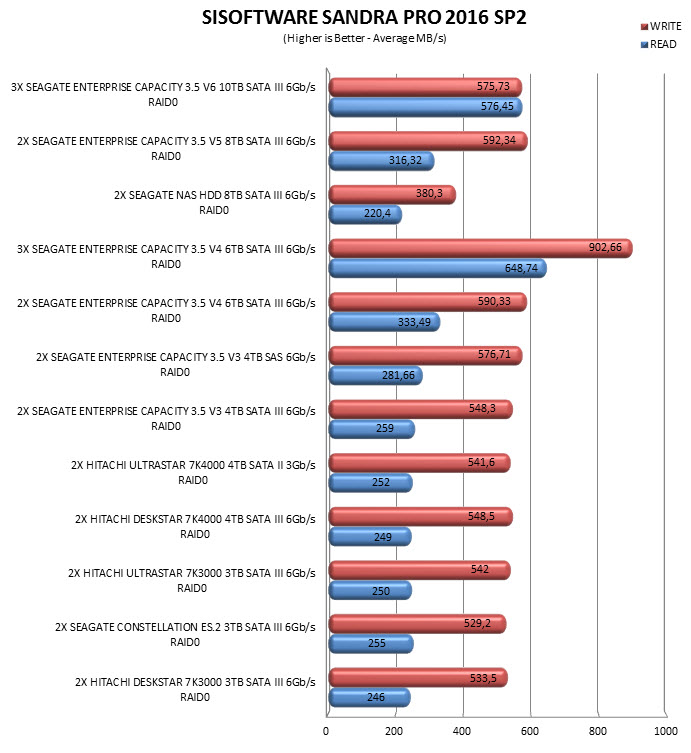
CONCLUSION

As we’ve mentioned quite a few times in the past mechanical drives have finally hit their performance ceiling but that doesn’t mean manufacturers can’t squeeze slightly more read & write performance out of them and the Seagate Enterprise Capacity 3.5 V6 10TB HDD is a good example of that. Of course manufacturers always have the option of marrying such drives with a good amount of NAND flash to increase their read & write performance (at least when it comes to cached data) but since they are mostly used for data/cloud storage performance obviously comes second to capacity. Using helium instead of air inside drives in order to reduce platter friction and improve on performance, temperatures and power consumption is not something new and as a matter of fact HGST has been doing it for years (we tested their first model a few years back). It did take a little while for Seagate to release their very own solution based on it since air was more than sufficient for their past models so my guess is that they’ll be using it quite a bit with their upcoming lines as well (especially higher capacity ones since 12TB models have already been announced). In terms of endurance the Enterprise Capacity 3.5 V6 10TB HDD sports the highest numbers we’ve ever seen given to a mechanical disk drive and that should go a long way not only with professionals but primarily with Cloud services and enterprises in general.
Enterprise HDD models always cost quite a bit and if you’ve been following our past reviews then you know this already. The Enterprise Capacity 3.5 V6 10TB HDD is also a massive 10TB drive so it couldn’t come cheap and with a current price tag set at USD444.45 inside the USA (Amazon.com) and 464.99Euros inside the EU (Amazon.de) it’s certainly not. The good news is that the Enterprise Capacity 3.5 V6 10TB drive is not really more expensive compared to the Barracuda Pro 10TB drive (roughly 20USD/Euros) and if we take into account the higher performance levels and higher endurance numbers getting the first is really a no brainer (Seagate should consider reducing the price of the Barracuda Pro to make it more appealing to consumers). So if you’re currently looking to get your hands on the fastest 3.5” 10TB HDD in the market this is the one for you and that’s also why it gets our Platinum Award.

PROS
- Build Quality (500WRL / 2.5 Million Hours MTBF)
- Top Of The Charts Read & Write Performance
- 256MB Cache
- 10TB's Capacity
- Temperatures / Noise Levels / Power Consumption
- Enclosure Material / Helium Filled (Low Temperatures / Reduced Platter Friction)
- 5 Year Limited Warranty
- Price (Compared To The Barracuda Pro)
CONS
- Price (For Some)

 O-Sense
O-Sense






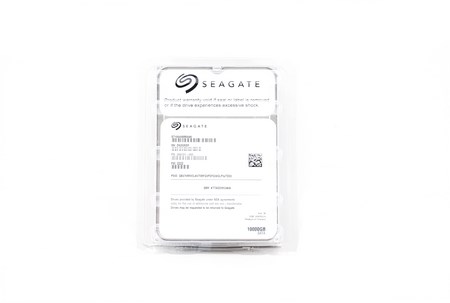






.png)

